
A tall ship is a large, traditionally-rigged sailing vessel. Popular modern tall ship rigs include topsail schooners, brigantines, brigs and barques. "Tall ship" can also be defined more specifically by an organization, such as for a race or festival.

A cutter is a name for various types of watercraft. It can apply to the rig of a sailing vessel, to a governmental enforcement agency vessel, to a type of ship's boat which can be used under sail or oars, or, historically, to a type of fast-sailing vessel introduced in the 18th century, some of which were used as small warships.
This glossary of nautical terms is an alphabetical listing of terms and expressions connected with ships, shipping, seamanship and navigation on water. Some remain current, while many date from the 17th to 19th centuries. The word nautical derives from the Latin nauticus, from Greek nautikos, from nautēs: "sailor", from naus: "ship".
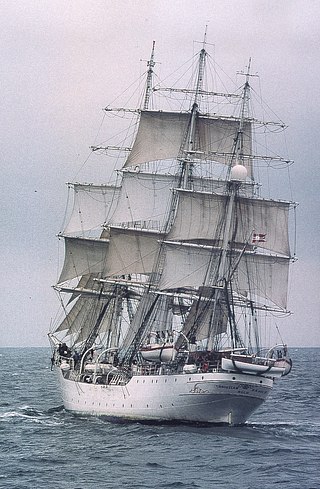
A full-rigged ship or fully rigged ship is a sailing vessel with a sail plan of three or more masts, all of them square-rigged. Such a vessel is said to have a ship rig or be ship-rigged, with each mast stepped in three segments: lower, top, and topgallant.

A Thames sailing barge is a type of commercial sailing boat once common on the River Thames in London. The flat-bottomed barges, with a shallow draught and leeboards, were perfectly adapted to the Thames Estuary, with its shallow waters and narrow tributary rivers. The larger barges were seaworthy vessels, and were the largest sailing vessel to be handled by just two men. The average size was about 120 tons and they carried 4,200 square feet (390 m2) of canvas sail in six working sails. The mainsail was loose-footed and set up with a sprit, and was brailed to the mast when not needed. It is sheeted to a horse, as is the foresail; they require no attention when tacking. The foresail is often held back by the mate to help the vessel come about more swiftly.

Iron-hulled sailing ships represented the final evolution of sailing ships at the end of the age of sail. They were built to carry bulk cargo for long distances in the nineteenth and early twentieth centuries. They were the largest of merchant sailing ships, with three to five masts and square sails, as well as other sail plans. They carried lumber, guano, grain or ore between continents. Later examples had steel hulls. They are sometimes referred to as "windjammers" or "tall ships". Several survive, variously operating as school ships, museum ships, restaurant ships, and cruise ships.
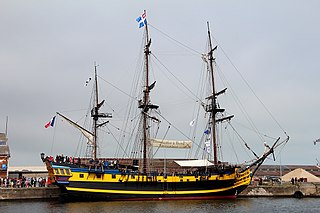
Étoile du Roy, formerly Grand Turk, is a three-masted sixth-rate frigate, designed to represent a generic warship during the Age of Sail, with her design greatly inspired by HMS Blandford. The ship was built in Marmaris, Turkey, in 1996 to provide a replica of a frigate for the production of the ITV series adapted from the novels about Royal Navy officer Horatio Hornblower by C. S. Forester. Nowadays the tall ship is used mainly in sailing events, for corporate or private charter, and for receptions in her spacious saloon or on her deck. In 2010 the French company Étoile Marine Croisières, based at Saint-Malo, Brittany, purchased the ship and renamed her Étoile du Roy.

Suomen Joutsen is a steel-hulled full-rigged ship with three square rigged masts. Built in 1902 by Chantiers de Penhoët in St. Nazaire, France, as Laënnec, the ship served two French owners before she was sold to German interest in 1922 and renamed Oldenburg. In 1930, she was acquired by the Government of Finland, refitted to serve as a school ship for the Finnish Navy and given her current name. Suomen Joutsen made eight long international voyages before the Second World War and later served in various support and supply roles during the war. From 1961 on she served as a stationary seamen's school for the Finnish Merchant Navy. In 1991, Suomen Joutsen was donated to the city of Turku and became a museum ship moored next to Forum Marinum.

A jackass-barque, sometimes spelled jackass bark, is a sailing ship with three masts, of which the foremast is square-rigged and the main is partially square-rigged and partially fore-and-aft rigged (course). The mizzen mast is fore-and-aft rigged.
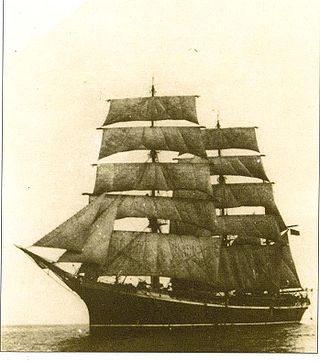
Glenlee is a steel-hulled three-masted barque, built as a cargo ship at Port Glasgow under that name in 1896 for Glasgow owners. With later owners she was named Islamount and Clarastella. From 1922 she was the sail training ship Galatea in the Spanish Navy. Since 1993, carrying her original name, Glenlee has been a museum ship at the Riverside Museum on Pointhouse Quay, Glasgow, known as The Tall Ship at Glasgow Harbour.

HMS Achilles was an armoured frigate built for the Royal Navy in the 1860s. Upon her completion in 1864 she was assigned to the Channel Fleet. The ship was paid off in 1868 to refit and be re-armed. When she recommissioned in 1869, she was assigned as the guard ship of the Fleet Reserve in the Portland District until 1874. Achilles was refitted and re-armed again in 1874 and became the guard ship of the Liverpool District in 1875. Two years later, she was rejoined the Channel Fleet before going to the Mediterranean in 1878. The ship returned to the Channel Fleet in 1880 and served until she was paid off in 1885.

Preussen (PROY-sin) was a German steel-hulled, five-masted, ship-rigged sailing ship built in 1902 for the F. Laeisz shipping company and named after the German state and kingdom of Prussia. She was the world's only ship of this class with five masts, carrying six square sails on each mast.

Baron of Renfrew was a four-masted barque of 5,294 gross register tonnage (GRT), built of wood in 1825 by Charles Wood in Quebec, Canada. She was one of the largest wooden ships ever built, although she was a disposable ship built for a one-way voyage to transport timber to England and did not complete a single voyage before breaking up.

The SV Tenacious is a modern British wooden sail training ship, specially designed in the 1990s. When completed in 2000, it was the largest wooden ship to be built in the UK for over 100 years.

Potosi was a five-masted steel barque built in 1865 by Joh. C. Tecklenborg ship yard in Geestemünde, Germany, for the sailing ship company F. Laeisz as a trading vessel. Its primary purpose was as a "nitrate clipper" collecting guano in South America for use in chemical companies in Germany. As its shipping route was between Germany, Bolivia until 1870 but, during the "pacific War" was transferred to Chile, it was designed to be capable of withstanding the rough weather encountered around Cape Horn.

The tall ship Spirit of New Zealand is a steel-hulled, three-masted barquentine from Auckland, New Zealand. It was purpose-built by the Spirit of Adventure Trust in 1986 for youth development. It is 42.5 m in total length and carries a maximum of 40 trainees and 14 crew on overnight voyages. The ship's home port is Auckland, and it spends most of its time sailing around the Hauraki Gulf. During the summer season, it often sails to the Marlborough Sounds and Nelson, at the top of the South Island.
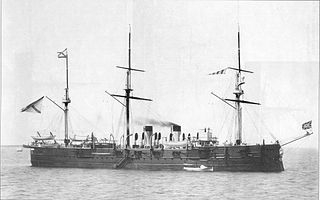
The Russian cruiser Minin was an armored cruiser built for the Imperial Russian Navy during the 1860s and 1870s. She was renamed Ladoga in 1909 when converted to a minelayer. The ship was sunk in 1915 when she struck a mine laid by a German submarine in the Baltic Sea.
Endeavour II was a three-masted auxiliary barque built in Vancouver in 1968 and originally named Monte Cristo. She was built along the lines of the brigantine Albatross as published in Uffa Fox's Second Book of Boats.

The SB Kathleen was a spritsail Thames barge built by Glover at Gravesend, Kent, in England in 1901, and registered in Rochester. Her official number was 113,708. She was built to carry grain- for capacity rather than speed. she was 82.8 feet (25.2 m) long and had a beam of 19.7 feet (6.0 m). Light, she drew 30 inches (76 cm) of water, and laden 6 feet (1.8 m).
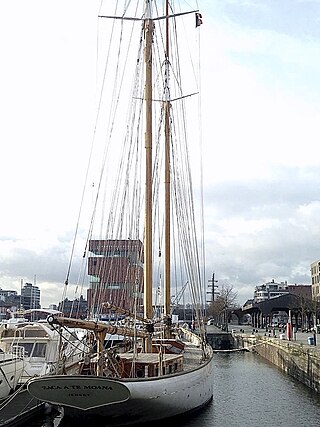
The yacht Zaca A Te Moana is a schooner with fore-and-aft rig built in 1992 at Ouderkerk aan de Amstel, in Netherlands. The naval architect is Olivier Van Meer, and the interior architect is Ed Kastelein.





















